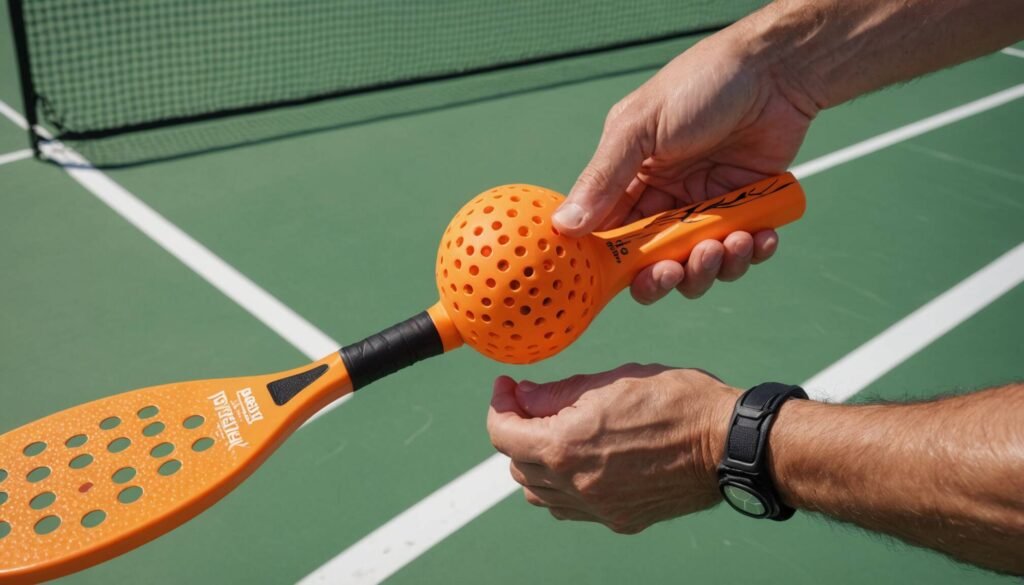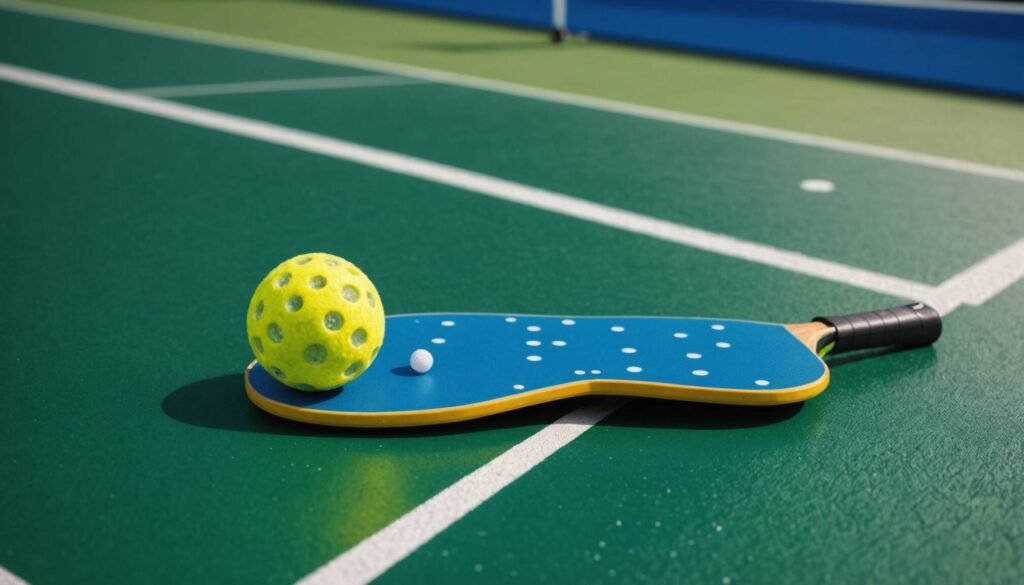The Ultimate Guide to Changing Your Pickleball Paddle Overgrip
In the world of pickleball, players often focus on paddle weight, core materials, and edge guards when discussing equipment. However, there’s one crucial element that frequently gets overlooked: the grip. This thin, cushioned layer between your hand and the paddle plays a vital role in determining your control and comfort during play. So, how often should you change your pickleball paddle overgrip? Let’s dive into this often-neglected aspect of pickleball gear maintenance and uncover some surprising insights from the pickleball community.
The Current State of Grip Changing: What the Numbers Reveal
A recent poll conducted by The Dink Pickleball revealed some interesting statistics about how often players change their paddle grips:
- 2.35% of players replace their grip after every game (an impressive level of dedication)
- 10.6% change it once a week, staying ahead of wear and tear
- 13.09% refresh their grip every two weeks, which is solid for regular players
- 44.97% wait about a month—the most common approach
- 28.99% said they never change their grip because they didn’t even know it was necessary
These numbers are eye-opening, especially considering that nearly a third of players are using the same grip indefinitely. This approach is akin to never changing your running shoes or using the same overgrip in tennis until it falls apart. It’s clear that many players may be unknowingly compromising their performance and potentially risking injury due to worn-out grips.
Why Your Grip Matters More Than You Might Think
The importance of a good grip extends far beyond mere comfort. A worn-out grip can significantly impact your entire game in several ways:
1. Reduced Traction Leads to More Mistakes
When your grip loses its traction, your hand is more likely to slip during play. This lack of control can lead to mis-hits, reduced power, and overall decreased accuracy in your shots. Imagine trying to execute a precise dink or a powerful smash with a paddle that’s constantly shifting in your hand – it’s a recipe for frustration and poor performance.
2. Increased Sweat Absorption Accelerates Breakdown
Grips are designed to absorb moisture, which is great for keeping your hand dry during play. However, over time, this moisture buildup can weaken the grip material. As the grip deteriorates, it becomes less effective at both absorbing sweat and providing traction, creating a vicious cycle of decreased performance.
3. Worn Grips Lead to Increased Tension
When players feel their grip slipping, they often compensate by gripping the paddle tighter. This unconscious adjustment can lead to increased hand fatigue and even wrist pain over time. A fresh, tacky grip allows you to hold the paddle with a relaxed, yet secure grip, reducing the risk of strain and allowing for more fluid, natural movements.
4. Deteriorating Padding Reduces Shock Absorption
The cushioning in your grip serves an important purpose beyond comfort – it helps absorb the shock of impact when you hit the ball. As this padding wears down, more of that impact is transferred directly to your arm. Over time, this increased strain can lead to discomfort or even injuries like tennis elbow or wrist pain.
Given these factors, it’s clear that maintaining a fresh grip is not just about comfort or aesthetics – it’s a crucial aspect of both performance and injury prevention in pickleball.
How Often Should You Really Change Your Grip?
While there’s no one-size-fits-all answer to how often you should change your pickleball paddle grip, we can provide some general guidelines based on playing frequency and style:
- Casual players (1-2 times a week): Change grip every 1-2 months
- Regular players (3-5 times a week): Change grip every 3-4 weeks
- Daily players or heavy sweaters: Change grip every 1-2 weeks
- Competitive or pro-level players: Consider replacing weekly
It’s important to note that these are just guidelines. You should always be attentive to the condition of your grip and replace it when you start noticing signs of wear, regardless of how long it’s been since your last change. Signs that it’s time for a new grip include slipping, fraying, or a sticky feel.
The Game-Changing Solution: Overgrips
If the idea of frequently replacing your entire grip seems daunting or expensive, there’s a fantastic solution: overgrips. An overgrip is a thin wrap that goes over your existing grip, providing fresh traction without the need to replace the entire grip. Here are some key benefits of using overgrips:
- Cost-effective: Overgrips are generally less expensive than full replacement grips
- Easy to apply: They can be quickly wrapped around your existing grip
- Customizable: Overgrips come in various textures and thicknesses, allowing you to tailor the feel of your paddle
- Preserves the original grip: By using overgrips, you extend the life of your paddle’s original grip
Selkirk’s overgrips are particularly popular among pickleball players, offering a good balance of tackiness, absorption, and durability.
Signs It’s Time for a New Grip or Overgrip
Not sure if you need to change your grip? Watch out for these telltale signs:
- Your hand slips, even when dry
- The grip feels hard, slick, or loses its tackiness
- The edges are fraying or peeling
- Your hand cramps or feels fatigued faster than usual
- The grip has an unpleasant odor (a sign of bacteria buildup)
If you’re experiencing any of these issues, it’s definitely time to consider a grip change.
Choosing the Right Overgrip: What’s Your Style?
Just as players have preferences for paddle weight and shape, the type of overgrip you choose can significantly impact your game. Here’s a breakdown of the most popular types of overgrips and what they offer:
1. Tacky Overgrips: For Maximum Hold
Tacky overgrips provide a slightly sticky surface that enhances control, especially in fast-paced games where quick reactions matter. These are ideal for:
- Players who sweat minimally but want extra grip
- Those who prefer a confident, locked-in feel
- Competitive players who rely on fast hand speed
However, tacky grips may not be the best choice for players who sweat a lot or play in hot, humid conditions, as they can become slick over time.
2. Dry Overgrips: Sweat Absorption Specialists
If you tend to have sweaty hands during play, a dry overgrip might be your best bet. These grips are designed to wick moisture away, keeping your hold secure even in intense matches. They’re perfect for:
- Players who sweat a lot or play in humid conditions
- Those who prefer a soft, powdery feel instead of a sticky one
- Anyone who wants a consistent grip even when things heat up
Keep in mind that dry grips tend to wear out faster than tacky ones, so you might need to replace them more frequently.
3. Cushioned Overgrips: Extra Comfort, Less Shock
If you find your hands or wrists getting sore after long matches, a cushioned overgrip might be the solution. These grips add an extra layer of padding to absorb impact, reducing strain on your hand and arm. They’re best for:
- Players with joint or wrist sensitivity
- Those who prefer a softer, more comfortable grip
- Anyone who plays long sessions and needs extra durability
Keep in mind that cushioned grips can be slightly thicker than other types, which may not be ideal if you have smaller hands or prefer a thinner grip.
4. Perforated Overgrips: The Best of Both Worlds
Perforated grips offer a hybrid solution, featuring tiny holes that help with moisture absorption while still providing a tacky feel. These are great for:
- Players who sweat a moderate amount
- Those who want a balance of tackiness and moisture control
- People looking for a durable option that doesn’t wear out too quickly
Finding Your Perfect Fit
Choosing the right overgrip is a personal decision that can depend on various factors including your playing style, hand size, and even the climate you play in. Don’t be afraid to experiment with different types to find what works best for you. Some players even switch between different types of grips depending on the season or playing conditions.
For example, you might use a tacky grip in cooler weather for maximum control, but switch to a dry grip in summer to combat increased sweating. The key is to pay attention to how your grip feels and performs, and be willing to make changes as needed.
The Impact of Proper Grip Maintenance on Your Game
While it might seem like a small detail, maintaining a fresh and appropriate grip on your pickleball paddle can have a significant impact on your overall game. Here’s how:
Improved Control and Accuracy
A well-maintained grip allows you to hold the paddle securely without excessive tension in your hand and arm. This relaxed yet firm hold translates to better control over your shots, allowing for more precise placement and improved shot consistency.
Enhanced Power and Spin
When your grip is secure, you can focus on generating power and spin without worrying about the paddle slipping in your hand. This confidence allows you to swing more freely, potentially increasing the power and spin on your shots.
Reduced Fatigue and Injury Risk
A good grip reduces the need to squeeze the paddle tightly, which can lead to hand and arm fatigue over long playing sessions. By allowing for a more relaxed grip, you’re less likely to experience strain or develop overuse injuries like tennis elbow.
Better Adaptation to Playing Conditions
By having the right grip for your playing style and conditions, you can maintain consistent performance regardless of weather or how long you’ve been playing. This adaptability can give you an edge in competitive situations.
Grip Changing: A Small Investment for Big Returns
When you consider the potential benefits of regularly changing your grip or using overgrips, it becomes clear that this small maintenance task can have a significant impact on your pickleball experience. Here’s why it’s worth the investment:
Cost-Effective Performance Boost
Compared to buying a new paddle or taking lessons, regularly changing your grip is an incredibly cost-effective way to improve your game. For just a few dollars and a few minutes of your time, you can ensure that you’re always playing with optimal grip conditions.
Prolonged Paddle Life
By using overgrips and changing them regularly, you’re actually protecting your paddle’s original grip. This can extend the overall life of your paddle, saving you money in the long run.
Consistency in Your Game
With a consistent grip feel, you can focus on developing your skills and strategy without being distracted by equipment issues. This consistency can be crucial for improving your game over time.
Hygiene and Comfort
Regular grip changes not only improve performance but also contribute to better hygiene. A fresh grip is less likely to harbor bacteria or develop unpleasant odors, making your playing experience more enjoyable.
Final Thoughts: A Small Change for a Big Difference
Changing your pickleball paddle grip or overgrip is one of the easiest and most effective ways to improve your performance on the court. It’s a quick, affordable adjustment that can prevent everything from mishits to hand strain, allowing you to focus on enjoying the game and improving your skills.
If you’re among the 28.99% who have never changed their grip, now is the perfect time to start. Your paddle—and your game—will thank you. Remember, pickleball is about continuous improvement, both in skills and equipment care. By paying attention to details like your grip, you’re setting yourself up for success and enjoyment every time you step onto the court.
So next time you pick up your paddle, take a moment to assess your grip. Is it still providing the traction and comfort you need? If not, it might be time for a change. Your future self, with better shots and fewer aches, will thank you for this simple yet impactful upgrade to your pickleball gear maintenance routine.



